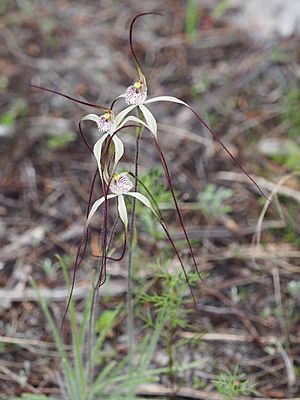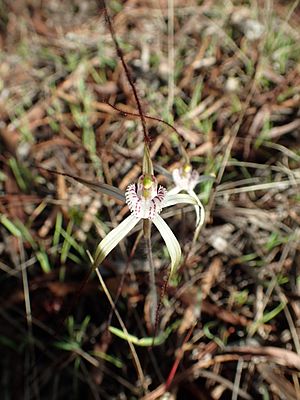Pendant spider orchid facts for kids
Quick facts for kids Pendant spider orchid |
|
|---|---|
 |
|
| Caladenia pendens subsp. pendens near Bunbury | |
| Scientific classification |
|
| Kingdom: | Plantae |
| Clade: | Tracheophytes |
| Clade: | Angiosperms |
| Clade: | Monocots |
| Order: | Asparagales |
| Family: | Orchidaceae |
| Subfamily: | Orchidoideae |
| Tribe: | Diurideae |
| Genus: | Caladenia |
| Species: |
C. pendens
|
| Subspecies: |
C. p. subsp. pendens
|
| Trinomial name | |
| Caladenia pendens subsp. pendens |
|
The Caladenia pendens subsp. pendens, also known as the pendant spider orchid, is a special plant. It belongs to the orchid family. This orchid only grows in the south-west part of Western Australia. It has one fuzzy leaf. Its flowers are creamy-white and quite big. They have long parts that hang down, like a pendant. Sometimes, these flowers have a sweet smell.
Contents
What Does the Pendant Spider Orchid Look Like?
The pendant spider orchid is a ground-dwelling plant. It is a perennial herb, which means it lives for many years. It has an underground tuber, like a small potato. Each year, it grows a single, upright, hairy leaf. This leaf is about 80 to 130 mm (3 to 5 inches) long. It is also about 5 mm (0.2 inches) wide.
The orchid can grow up to three creamy-white flowers. These flowers are large, about 120 to 180 mm (5 to 7 inches) long. They can be 100 to 160 mm (4 to 6 inches) wide. The flowers grow on a stem that is 150 to 300 mm (6 to 12 inches) tall. The parts of the flower that look like petals and sepals have long, brown, thread-like tips. These tips hang downwards.
The top sepal stands up straight. It is about 60 to 120 mm (2 to 5 inches) long. The two side sepals are also 60 to 120 mm long. They point downwards near their base. The petals spread out sideways at first. Then they also droop downwards. They are about 80 to 120 mm (3 to 5 inches) long.
The labellum is a special lip-like part of the flower. It is about 15 to 19 mm (0.6 to 0.7 inches) long. It is creamy-white with red lines and spots. The sides of the labellum curve upwards. They have small, blunt teeth along their edges. The very tip of the labellum curves downwards. There are two rows of cream-colored, anvil-shaped bumps called calli in the middle of the labellum. This orchid flowers from August to early October.
How Did It Get Its Name?
The pendant spider orchid was first officially described in 2001. Two scientists, Stephen Hopper and Andrew Phillip Brown, gave it its name. They published their description in a science journal called Nuytsia.
The word pendens comes from Latin. It means "hanging" or "dangling." This name was chosen because of the long petals and side sepals. They hang down, just like a pendant.
Where Does It Live?
You can find the pendant spider orchid in many areas of Western Australia. It grows between Wongan Hills and Walpole. These areas include the Avon Wheatbelt, Esperance Plains, and Jarrah Forest. It also lives in the Geraldton Sandplains, Mallee, Swan Coastal Plain, and Warren regions.
This orchid likes to grow in sandy soil. You can often find it near salt lakes. It also grows on granite outcrops, which are rocky areas.
Is It Safe?
The Western Australian Government's Department of Parks and Wildlife checks on plants. They have classified the pendant spider orchid as "not threatened." This means it is not currently in danger of disappearing.


